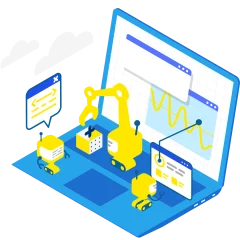Agile methods bring speed and adaptability to software development. But what does it actually mean to work in an agile way and what advantages does agile software development bring for development teams and clients?
What is agile development?
In the traditional software development process, projects often go through rigid phases, from requirements analysis to final implementation. Project managers generally use the waterfall model here.
Agile development, on the other hand, relies on flexibility and short iterations. Scrum is a popular example. Instead of planning the entire project in advance, the software is developed in small, functional units. The benefits are obvious: small bites of software are easier for the customer to test and accept. Not to mention the development team, which has fewer large chunks to deal with. The result is faster results due to ever shorter release cycles.
The basic principles of agile methods are therefore as follows:
- Iterative approach: The software is developed in short cycles (also known as sprints) in which prioritized requirements are implemented.
- Continuous improvement: The result is reviewed and adapted after each sprint.
- Close cooperation: Developers, specialist users and clients work closely together as a team.
- Transparency: The progress of the project can be viewed by everyone involved at any time.
What are the benefits of agile development?
As already mentioned, splitting tasks into small pieces is an elementary component of agile software development. This offers you decisive advantages over traditional approaches from classic project management:
Faster delivery of functional software: instead of having to wait for the complete software, you receive usable partial functions after a short time.
Greater flexibility when requirements change: New ideas or changing business requirements can be taken into account during the ongoing project.
Better customer involvement and transparency: close collaboration with your team means you always have an insight into the progress of the project and can provide feedback at an early stage.
Reduced project risk and faster troubleshooting: The iterative processes allow errors to be identified and rectified at an early stage.
Agile methods at a glance
Various agile frameworks such as Scrum, Kanban or Scrumban structure the agile approach. However, there is no single method. Good product teams therefore always select the framework used according to their needs.
Scrum: Probably the most popular agile framework
Scrum divides the project into short sprints (e.g. 2-4 weeks). In each sprint, a manageable package of functionalities is implemented, which is prioritized in the so-called “product backlog”. In this way, high-quality software solutions that meet the individual needs of customers are created quickly and flexibly.
The advantages include a fast market launch thanks to a high release frequency, as well as greater flexibility in the event of change requests. In addition, the overall product quality increases because feature blocks are easier to test and manage, which ultimately leads to improved customer satisfaction.
Scrum is particularly suitable for product development, but enjoys great popularity in most software projects. It is the de facto standard in agile software development and is often mixed or supplemented with other methods.
Other agile frameworks and methods
| Principle | Benefits | Use | |
| Kanban | Visualization of the work flow on a Kanban board | Easy to use, high transparency, suitable for continuous further development | Software development, but also in other areas such as marketing or customer service |
| Scrum of Scrums | Scaling Scrum for large teams or multiple teams working on one project | Improved coordination and synchronization of teams, avoidance of bottlenecks | Complex projects with several teams, e.g. in the automotive industry or in finance |
| Extreme Programming (XP) | Focus on quality assurance and continuous integration | Avoidance of errors, fast delivery of executable software | Software development projects with high quality requirements, e.g. in medical technology or the aviation sector |
| Lean Startup | Rapid development and validation of business ideas through iterative prototypes and customer feedback | Minimizing risks, failing quickly and learning from mistakes | Founding new companies or developing new products and services |
| Design Thinking | User-centered development of solutions through iterative prototypes and tests | Increasing user satisfaction, developing innovative products and services | Various areas of application, e.g. in product development, marketing or education |

